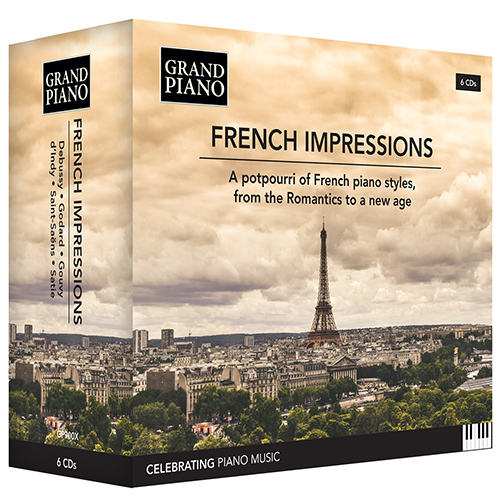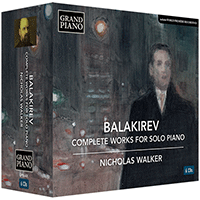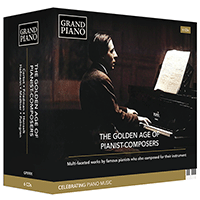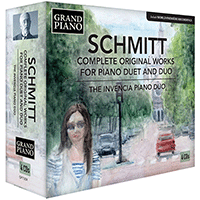
About this Release
Catalogue No.: GP900X
Release Date: June 2022
Barcode: 747313990023
Composer(s):
Link(s):
FRENCH IMPRESSIONS
A Potpourri of French Piano Styles, from the Romantics to a New Age (6-CD Boxed Set)
The range and variety of French piano music in the 19th and 20th centuries is exemplifi ed in these critically acclaimed albums bringing together rarely encountered pieces, a number of which are performed on period instruments. Théodore Gouvy’s little-known sonatas and Benjamin Godard’s fragrant lyricism are part of a lineage that includes the masterful large-scale Piano Sonata of Vincent d’Indy, the virtuosic rarities – many in première recordings – of Saint-Saëns, Satie’s tenderness and wit, and unknown piano versions of some of Debussy’s greatest orchestral masterpieces.
Tracklist
Disc 1
|
Gouvy, Louis Theodore
|
|
Sonata for Piano 4 Hands in D Minor, Op. 36 (1861) (00:26:29 )
|
|
1
I. Allegro moderato (00:09:20)
|
|
2
II. Adagio (00:07:30)
|
|
3
III. Intermezzo: Allegretto (00:04:43)
|
|
4
IV. Epilogue: Moderato assai quasi larghetto (00:04:58)
|
|
Sonata for Piano 4 Hands in C Minor, Op. 49 (1869) (00:29:44 )
|
|
5
I. Allegro moderato (00:10:18)
|
|
6
II. Larghetto (00:09:50)
|
|
7
III. Minuetto: Moderato (00:04:12)
|
|
8
IV. Finale: Allegro vivace (00:05:27)
|
|
Sonata for Piano 4 Hands in F Major, Op. 51 (1869) (00:19:59 )
|
|
9
I. Allegro con brio (00:09:19)
|
|
10
II. Andantino scherzoso (00:03:59)
|
|
11
III. Allegro risoluto (00:06:47)
|
Disc 2
|
Saint-Saëns, Camille
|
|
2 Bagatelles (1858) (00:05:00 )
|
|
1
Bagatelle No. 1 (00:02:19)
|
|
2
Bagatelle No. 2 (00:02:25)
|
|
3
Antwort (1866) (00:03:06)
|
|
4
Fantaisie sur la Quintette de L'Etoile du Nord de Meyerbeer (1858) (00:04:59)
|
|
5
Valse du Prophete de Meyerbeer (1857) (00:05:53)
|
|
6
Fantaisie sur Lohengrin de Wagner (1859) (00:07:49)
|
|
7
Chœur des Derviches Tourneurs Tiré des Ruines d'Athénes de Beethoven (1869) (00:02:36)
|
|
8
Paraphrase sur Gallia de Gounod (1871) (00:08:54)
|
|
9
Scherzo sur Les Pècheurs de Perles de Bizet (1886) (00:09:13)
|
|
10
La mort de Thaïs, paraphrase de concert pour piano sur l'opéra de Massenet (1895) (00:07:08)
|
|
11
Improvisation sur la Beethoven-Cantate de Liszt (1870) (00:11:59)
|
|
12
Africa, Op. 89 (1891) (00:11:32)
|
Disc 3
|
Debussy, Claude
|
|
1
L'enfant prodigue: Prélude (version for piano) (1884) (00:02:46)
|
|
2
Rodrigue et Chimène: Prélude (version for piano with concert ending, ed. R. Orledge) (1893) (00:04:58)
|
|
3
Préludes, Book 1: No. 8. La fille aux cheveux de lin (1907 first version of opening fragment in B-Flat Major) (1910) (00:00:46)
|
|
4
Prélude à l'histoire de Tristan (version for piano, completed R. Orledge, 2011) () (00:04:26)
|
|
5
Préludes, Book 2: No. 5. Bruyères (1912 first version) (1913) (00:03:51)
|
|
6
Toomai des éléphants (reconstructed R. Orledge, 2006) (new edition) (1913) (00:06:33)
|
|
7
Petite valse (completed by R. Orledge, 2006) (1915) (00:02:07)
|
|
8
Fêtes Galantes, Tableau 1: Les Masques (commencement) (completed R. Orledge for piano, 2006) (1913) (00:07:08)
|
|
9
Le martyre de St. Sébastien, Act III: Le concile des faux dieux: La passion (unused first draft, completed R. Orledge for piano, 2014) (1911) (00:04:28)
|
|
10
No-Ja-Li (Le Palais du Silence) (completed R. Orledge for narrator and piano, 2005/2014) () (00:17:17)
|
|
Le Roi Léar (completed R. Orledge for piano, 2004/2018) () (00:08:00 )
|
|
11
Prélude (00:03:52)
|
|
12
Fanfare (autre) (00:00:58)
|
|
13
Le Sommeil de Léar (00:03:36)
|
|
14
La Mort de Cordélia (00:03:36)
|
|
15
Un jour affreux avec le Diable dans le Beffroi (arr. R. Orledge for narrator and piano) () (00:11:37)
|
|
16
La Chute de la Maison Usher (completed R. Orledge for piano, 2010, cadanza by N. Horvath) () (00:06:30)
|
Disc 4
|
Satie, Erik
|
|
1
Pièce sans titre, "Caresse" (1897) (1897) (00:02:29)
|
|
2
Je te veux (1901) (00:05:37)
|
|
Jack in the Box (1899) (00:08:00 )
|
|
3
I. Prelude (00:02:47)
|
|
4
II. Entr'acte (00:02:46)
|
|
5
III. Final (00:02:31)
|
|
6
La mort de Monsieur Mouche: Prélude (1900) (00:01:32)
|
|
7
Verset laïque et somptueux (1900) (00:00:55)
|
|
8
Le Poisson rêveur (The Dreamy Fish), "Modéré" (1901) (00:07:09)
|
|
9
Le bœuf Angora (The Angora Ox) (version for piano) (1901) (00:05:42)
|
|
10
Poudre d'or (1902) (00:05:51)
|
|
11
Tendrement (version for piano) (1902) (00:03:00)
|
|
12
Illusion (1902) (00:04:51)
|
|
13
Le Piccadilly (1904) (00:01:54)
|
|
14
La Diva de l'Empire (Marche chantée dans la Revue Dévidons la bobine!) (1904) (00:01:56)
|
|
15
La Diva de l'Empire (Intermezzo américain d'après la célèbre chanson de Bonnaud, Blès et Satie) (arr. H. Ourdine for piano) (1904) (00:03:00)
|
|
Bach, Johann Sebastian
|
|
16
Nun ruhen alle Walder, BWV 392 (arr. E. Satie for piano) (1906) (00:01:24)
|
|
Satie, Erik
|
|
17
Pousse l'amour: Chanson andalouse (1906) (00:02:11)
|
|
18
[Exercise] [pour quatuor à cordes] (1905) (00:00:40)
|
|
19
Fugue-valse (1906) (00:01:34)
|
|
20
Passacaille (1906) (00:02:37)
|
Disc 5
|
Indy, Vincent d'
|
|
Piano Sonata, Op. 63 (1907) (00:35:00 )
|
|
1
I. Modéré: [Introduction] - (00:04:14)
|
|
2
I. Variation 1: Un peu plus animé - (00:01:44)
|
|
3
I. Variation 2: Lent - (00:02:10)
|
|
4
I. Variation 3: Plus vite - (00:02:26)
|
|
5
I. Variation 4: Modérément animé - (00:01:51)
|
|
6
I. Premier Mouvement du Thème - (00:01:23)
|
|
7
I. Thema mutatum (00:03:03)
|
|
8
II. Très animé - (00:00:48)
|
|
9
II. Un peu moins vite - (00:02:04)
|
|
10
II. Premier Mouvement: Très animé - (00:00:30)
|
|
11
II. [bars 99-156] - (00:02:05)
|
|
12
II. Au Mouvement (00:01:48)
|
|
13
III. Modéré - (00:02:43)
|
|
14
III. Même Mouvement - (00:01:21)
|
|
15
III. Un peu plus animé - (00:00:26)
|
|
16
III. Au Mouvement - (00:01:56)
|
|
17
III. Premier Mouvement - (00:02:27)
|
|
18
III. Thema premier Mouvement - (00:01:02)
|
|
19
III. Au Mouvement - (00:01:15)
|
|
20
III. Un peu plus animé - (00:00:33)
|
|
21
III. [bars 245-287] - (00:01:54)
|
|
22
III. Au Mouvement - (00:01:37)
|
|
23
III. Thema: Très large et puissant (00:03:41)
|
|
Tableaux de voyage, Op. 33 (1889) (00:37:00 )
|
|
24
No. 1. ? (00:01:48)
|
|
25
No. 3. Pâturage (00:02:54)
|
|
26
No. 4. Lac Vert (00:02:13)
|
|
27
No. 5. Le Glas (00:02:55)
|
|
28
No. 11. Beuron (00:02:07)
|
|
29
No. 12. La Pluie (00:05:20)
|
|
30
No. 13. Rêve (00:05:53)
|
Disc 6
|
Godard, Benjamin
|
|
1
Reve vecu, Op. 140 () (00:04:20)
|
|
2
Nocturne No. 1, Op. 68 () (00:04:20)
|
|
3
Nocturne No. 2, Op. 90 () (00:05:53)
|
|
4
Nocturne No. 3, Op. 139 () (00:06:00)
|
|
5
Nocturne No. 4, Op. 150 () (00:06:25)
|
|
3 Morceaux, Op. 16 (1874) (00:02:14 )
|
|
6
No. 1. Menuet (00:02:10)
|
|
7
No. 2. Andante (00:02:53)
|
|
8
No. 3. Gavotte (00:02:00)
|
|
Fantaisie, Op. 143 (1893) (00:14:55 )
|
|
9
I. Ballade (00:06:23)
|
|
10
II. Intermezzo: Vivace (00:03:52)
|
|
11
III. Scherzo: Final (00:04:52)
|
|
12
Renouveau, Op. 82 () (00:03:15)
|
|
Fragments poetiques, Op. 13 (1869) (00:14:24 )
|
|
13
No. 1. Lamartine (00:03:07)
|
|
14
No. 2. Alfred de Musset (00:05:27)
|
|
15
No. 3. Victor Hugo (00:02:01)
|
Total Time: 07:08:20
The Composer(s)
 Johann Sebastian Bach belonged to a dynasty of musicians. In following inevitable family tradition, he excelled his forebears and contemporaries, although he did not always receive in his own lifetime the respect he deserved. Despite widespread neglect for almost a century after his death, Bach is now regarded as one of the greatest of all composers. Bach-Werke-Verzeichnis numbers, abbreviated to BWV, are generally accepted for convenience of reference.
Johann Sebastian Bach belonged to a dynasty of musicians. In following inevitable family tradition, he excelled his forebears and contemporaries, although he did not always receive in his own lifetime the respect he deserved. Despite widespread neglect for almost a century after his death, Bach is now regarded as one of the greatest of all composers. Bach-Werke-Verzeichnis numbers, abbreviated to BWV, are generally accepted for convenience of reference.  Claude Debussy has exercised widespread influence over later generations of composers, both in his native France and elsewhere. He was trained at the Paris Conservatoire, and decided there on a career as a composer rather than as a pianist (his original intention). His highly characteristic musical language, thoroughly French in inspiration, extended the contemporary limits of harmony and form, and he had a remarkably delicate command of nuance, whether in piano writing or in the handling of a relatively large orchestra.
Claude Debussy has exercised widespread influence over later generations of composers, both in his native France and elsewhere. He was trained at the Paris Conservatoire, and decided there on a career as a composer rather than as a pianist (his original intention). His highly characteristic musical language, thoroughly French in inspiration, extended the contemporary limits of harmony and form, and he had a remarkably delicate command of nuance, whether in piano writing or in the handling of a relatively large orchestra.  Godard was a prolific composer and within the course of his short life he wrote three symphonies, four concertos, eight operas, three string quartets, four violin sonatas, and a tremendous range of further chamber works, piano solos and songs.
Godard was a prolific composer and within the course of his short life he wrote three symphonies, four concertos, eight operas, three string quartets, four violin sonatas, and a tremendous range of further chamber works, piano solos and songs.  Gouvy began piano lessons with a private tutor at the age of eight, and was educated in France—Sarreguemines, then Metz—developing a keen interest in Classical Greek culture and in modern languages—not only German, which he spoke fluently, but English and Italian as well. In 1837 he went to Paris to study law, continuing his piano lessons with a pupil of the pianist and composer Henri Herz (1803–1888). Two years later, he made up his mind to abandon any thoughts of a career in the law and to devote himself to music. He stood out in French musical life as a composer of orchestral and chamber music.
Gouvy began piano lessons with a private tutor at the age of eight, and was educated in France—Sarreguemines, then Metz—developing a keen interest in Classical Greek culture and in modern languages—not only German, which he spoke fluently, but English and Italian as well. In 1837 he went to Paris to study law, continuing his piano lessons with a pupil of the pianist and composer Henri Herz (1803–1888). Two years later, he made up his mind to abandon any thoughts of a career in the law and to devote himself to music. He stood out in French musical life as a composer of orchestral and chamber music.  Vincent d’Indy was born in Paris on 27 March 1851 into an aristocratic family from the Vivarais (Ardèche) region whose political sympathies lay with the Bourbon royal family. He was part of the European generation of composers that also includes Janáček, Chausson and Elgar.
Vincent d’Indy was born in Paris on 27 March 1851 into an aristocratic family from the Vivarais (Ardèche) region whose political sympathies lay with the Bourbon royal family. He was part of the European generation of composers that also includes Janáček, Chausson and Elgar.  Once described as the French Mendelssohn, Camille Saint-Saëns was talented and precocious as a child, with interests by no means confined to music. He made an early impression as a pianist. Following established French tradition, he was for nearly 20 years organist at the Madeleine in Paris and taught briefly at the École Niedermeyer, where he befriended his pupil Gabriel Fauré. He was a co-founder of the important Société Nationale de Musique with the patriotic aim of promoting contemporary French music in the aftermath of the Franco-Prussian war of 1870-01, in which he had served in the Garde Nationale de la Seine. Prolific and versatile as a composer, he contributed to most genres of music, but by the time of his death in 1921 his popularity in France had diminished considerably, as fashions in music had changed.
Once described as the French Mendelssohn, Camille Saint-Saëns was talented and precocious as a child, with interests by no means confined to music. He made an early impression as a pianist. Following established French tradition, he was for nearly 20 years organist at the Madeleine in Paris and taught briefly at the École Niedermeyer, where he befriended his pupil Gabriel Fauré. He was a co-founder of the important Société Nationale de Musique with the patriotic aim of promoting contemporary French music in the aftermath of the Franco-Prussian war of 1870-01, in which he had served in the Garde Nationale de la Seine. Prolific and versatile as a composer, he contributed to most genres of music, but by the time of his death in 1921 his popularity in France had diminished considerably, as fashions in music had changed.  A French composer as eccentric in his way of life as in his music, Satie exercised considerable influence over some of his more distinguished contemporaries, including Debussy, Ravel and Poulenc, particularly through his tendency towards extreme simplicity. A number of his compositions have become very familiar to many, largely through their use in other contexts.
A French composer as eccentric in his way of life as in his music, Satie exercised considerable influence over some of his more distinguished contemporaries, including Debussy, Ravel and Poulenc, particularly through his tendency towards extreme simplicity. A number of his compositions have become very familiar to many, largely through their use in other contexts. 





 Grand Piano has gained a reputation for producing high quality recordings of rare keyboard gems. Dedicated to the exploration of undiscovered piano repertoire, the label specialises in complete cycles of piano works by many lesser-known composers, whose output might otherwise have remained unknown and unrecorded.
Grand Piano has gained a reputation for producing high quality recordings of rare keyboard gems. Dedicated to the exploration of undiscovered piano repertoire, the label specialises in complete cycles of piano works by many lesser-known composers, whose output might otherwise have remained unknown and unrecorded.






